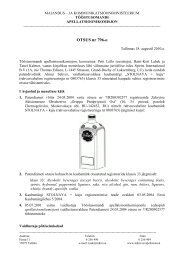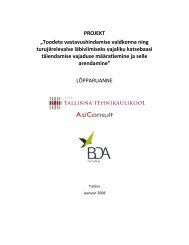Feasibility study for an Estonian Materials Technology Programme
Feasibility study for an Estonian Materials Technology Programme
Feasibility study for an Estonian Materials Technology Programme
You also want an ePaper? Increase the reach of your titles
YUMPU automatically turns print PDFs into web optimized ePapers that Google loves.
67<br />
<strong>Feasibility</strong> <strong>study</strong> <strong>for</strong> <strong>an</strong> Estoni<strong>an</strong> <strong>Materials</strong> <strong>Technology</strong> <strong>Programme</strong><br />
3. <strong>Materials</strong> technology abroad: co-operation <strong>an</strong>d competition<br />
3.2.2 Lithu<strong>an</strong>ia<br />
The Lithu<strong>an</strong>i<strong>an</strong> status in materials sciences is very similar to other Baltic countries. Adv<strong>an</strong>ced materials research<br />
<strong>an</strong>d technology development has been very recently studied by Valiulis <strong>an</strong>d Škamat (2010) 69 . The Lithu<strong>an</strong>i<strong>an</strong><br />
public R&D system consists of 21 universities, 9000 teaching staff <strong>an</strong>d 2800 PhD students. The strongest areas<br />
in research are biotechnology, biochemistry, chemistry, mathematics, physics (especially laser physics), ICT, electronics<br />
<strong>an</strong>d power-engineering.<br />
The following institutions <strong>an</strong>d universities <strong>an</strong>d their research areas have been identified in the <strong>study</strong> of Valiulis<br />
<strong>an</strong>d Škamat:<br />
Lithu<strong>an</strong>i<strong>an</strong> Energy Institute<br />
Production of thermo insulating fiber<br />
Synthesis of new catalytic coatings with active elements of metal oxides<br />
Plasma nitriding of austenitic stainless steels <strong>an</strong>d alloys<br />
Modification of materials surface layer by deposition of a – C:H films<br />
Deposition of hydrocarbons containing coatings <strong>an</strong>d yttrium stabilised zirconium coatings (especially<br />
<strong>for</strong> fuel cells)<br />
Semiconductor Physics Institute (SPI)<br />
<strong>Materials</strong> science <strong>an</strong>d n<strong>an</strong>otechnology<br />
Ultrafast processes in semiconductors <strong>an</strong>d superconductors<br />
Terahertz technology<br />
Metrology <strong>an</strong>d the development of National St<strong>an</strong>dards<br />
Institute of Physical Electronics, Kaunas University of <strong>Technology</strong><br />
Thin films <strong>an</strong>d surface engineering<br />
Application of ion <strong>an</strong>d plasma methods <strong>for</strong> n<strong>an</strong>ostructures <strong>an</strong>d n<strong>an</strong>omaterials<br />
Development of new materials <strong>an</strong>d structures<br />
Potential application areas: coatings <strong>for</strong> sensors <strong>an</strong>d MEMS devices, passive layers in microelectronics,<br />
wear <strong>an</strong>d chemical resist<strong>an</strong>t protective coatings <strong>for</strong> industry <strong>an</strong>d biomedical applications<br />
Vilnius Gediminas Technical University<br />
N<strong>an</strong>otechnologies in refractory materials (Institute of Thermal Insulation)<br />
Composite aircraft structures (Ant<strong>an</strong>as Gustaitis Aviation Institute)<br />
Heat treatment of alloy steel welded joints arc spray, coating technology (Department of <strong>Materials</strong><br />
Science <strong>an</strong>d Welding)<br />
The research institutions in Lithu<strong>an</strong>ia mostly focus on fundamental research <strong>an</strong>d the largest reason <strong>for</strong> lacking<br />
R&D effectiveness is said to be the absence of critical mass to support R&D activities. Improvement of the situation<br />
would require larger research institutions as well as better support from the business sector.<br />
Also similarly to other Baltic countries, Lithu<strong>an</strong>ia has prepared its own knowledge based economy <strong>study</strong> in<br />
2004. 70 The <strong>study</strong> highlights three high technology sectors with high potential <strong>for</strong> Lithu<strong>an</strong>ia including:<br />
Biotechnology sector<br />
Laser technology sector<br />
In<strong>for</strong>mation technology <strong>an</strong>d telecommunications sector<br />
The country has since established a number of National <strong>Technology</strong> Plat<strong>for</strong>ms, which are associations of enterprises,<br />
research institutions <strong>an</strong>d fin<strong>an</strong>cial groups operating in a specific sector of the Lithu<strong>an</strong>i<strong>an</strong> economy on<br />
the basis of a joint activity agreement. <strong>Technology</strong> plat<strong>for</strong>ms relev<strong>an</strong>t to materials technology include 7172 :<br />
Future m<strong>an</strong>ufacturing (36 members)<br />
Apparel <strong>an</strong>d textile industry (10 members)<br />
Biotechnology (29 members)<br />
Photoelectricity (10 members)<br />
69 Adv<strong>an</strong>ced <strong>Materials</strong> Research <strong>an</strong>d Technologies Development: Lithu<strong>an</strong>i<strong>an</strong> Experience (2010)<br />
70 The Knowledge Economy in Lithu<strong>an</strong>ia – A <strong>study</strong> of The Industry’s Prospects (http://www.innovation.lv/ino2/publications/<br />
knowledgeeconomy.pdf)<br />
71 http://www.tpa.lt/ENG/FP7/files/NTP_plat<strong>for</strong>ms.pdf<br />
72 http://www.ntplat<strong>for</strong>mos.lt





